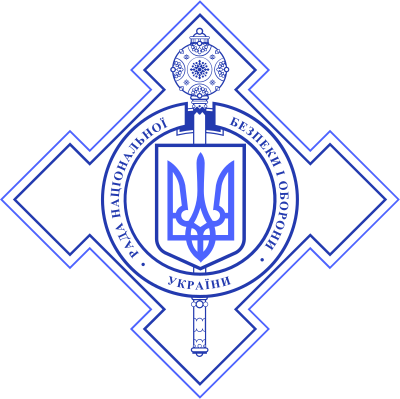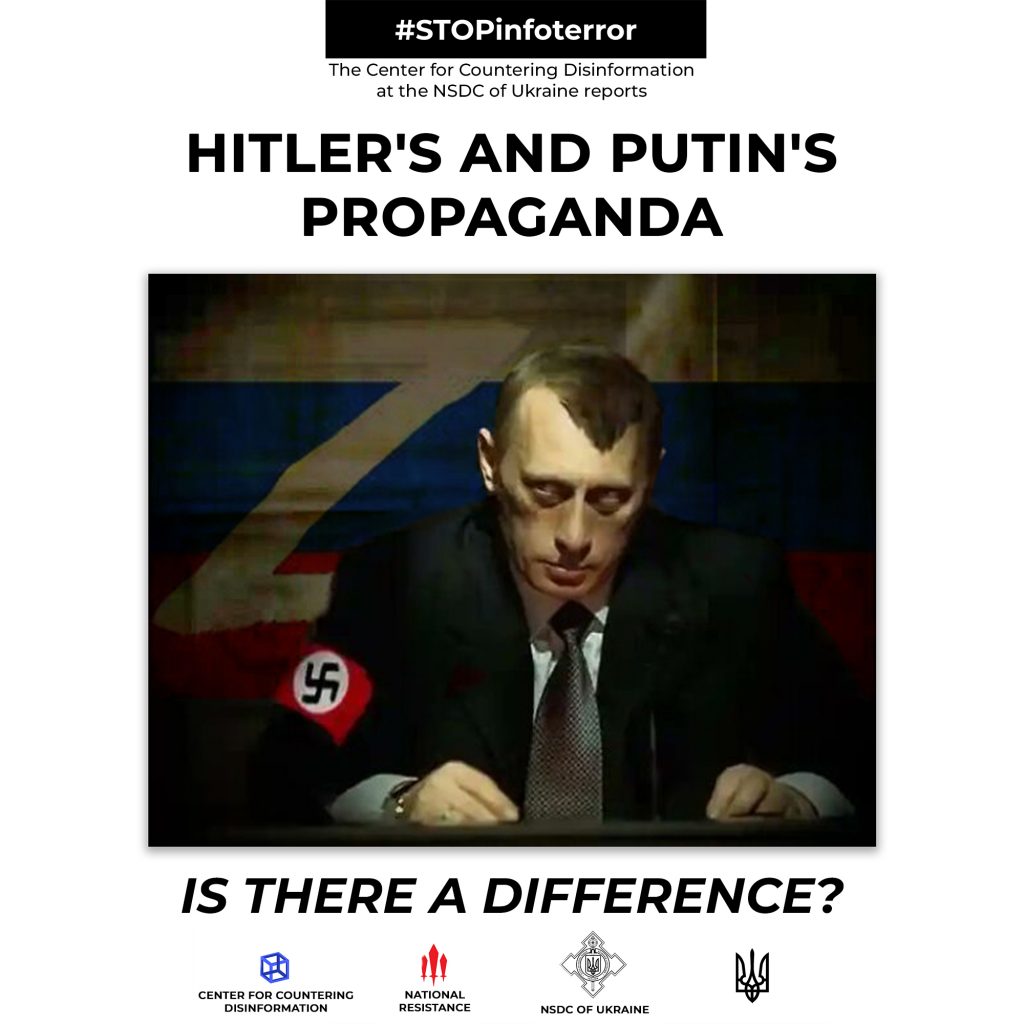The Nazis used propaganda effectively to win the support of millions for German democracy. But unfortunately, the Nazi regime later used the same technology to support the introduced dictatorship to organize persecution, start a war, and ultimately commit genocide. Since the ’90s, Russian propaganda tried to exercise the same regarding russians’ attitudes toward Ukrainians. So, here are the shared features:
1. The Nazis were experienced propagandists who used sophisticated advertising techniques and the most up-to-date technologies to spread their ideology.
Russian propaganda ideologists also employ the latest technologies. Along with mass media, the social networks Vkontakte, Odnoklassniki, and Telegram messenger forums have joined the propaganda spread.
The main propaganda TV channels are RT, Channel One, Russia-24, Russia-1, NTV, RBC TV, and the russian News Agency TASS.
The symbols Z, V, ∆ launched by Russian propaganda, were intended to evoke pride in the victory of the “russian world” but caused the civilized world to identify the occupying forces with the Nazi’s swastika directly.
2. After gaining power, Adolf Hitler created The Reich Ministry for Public Enlightenment and Propaganda to influence Germans’ public opinion and behavior.
Russian propagandists use the Ministry of Defense of the russian federation, the Ministry of Foreign Affairs of the russian federation, and the Ministry of Education of the russian federation to spread propaganda and hatred of everything Ukrainian in addition to television and the Internet.
3. Nazi propaganda played a vital role in the persecution and, ultimately, the extermination of European Jews. Propaganda incited hate and fostered an atmosphere of indifference to Jewish fate.
Russian propaganda conducts a “special military operation” to neutralize Ukrainian nationalists on Ukraine’s territory – that is, in fact, a full-blown war and genocide against the Ukrainian nation.
Let’s try to dwell on and compare the propaganda ideology of Hitler and Putin:
1. The spread of Nazism.
In 1924 Hitler wrote that propaganda’s “task is not to make an objective study of the truth, in so far as it favours the enemy, and then set it before the masses with academic fairness. Its task is to serve our own right, always and unflinchingly.”
Nazi propaganda often depicted Jews as rebels who secretly prepared provocations to incite war: a stereotypical Jew conspired behind the scenes to rule the Allied Powers, the “Big Three”—the United Kingdom, the Soviet Union, and the United States.
After the Nazis seized power in 1933, Hitler created the Reich Ministry for Public Enlightenment and Propaganda, headed by Joseph Goebbels. The ministry aimed to spread Nazi ideology through art, music, theater, films, books, radio, educational materials, and the press.
Nazi propaganda had several target audiences. First, the Germans were reminded of the need to fight against foreign enemies and the Jewish subversive activities. Second, propaganda campaigns created an atmosphere of tolerance for violence against Jews, particularly in 1935 (before the Nuremberg Race Laws passed in September) and 1938 (before the flurry of anti-Semitic economic legislation that followed the Night of Broken Glass). Third, propaganda encouraged passivity and acceptance of future measures against the Jews, convincing the German nation that the Nazi government was coming to the rescue to “restore the order.”
The object of Nazi propaganda was ethnic Germans’ discrimination in Czechoslovakia and Poland (Eastern European countries that acquired former German territories after the First World War). The discrimination partially existed, but propaganda significantly amplified the reality. It aimed to achieve political loyalty and spread the so-called racial consciousness among ethnic Germans. It also intended to mislead and convince foreign governments, the major European powers in particular, that Nazi Germany’s demands for concessions and annexations were legitimate and just.
After the German invasion of the Soviet Union, Nazi propaganda emphasized the connection of Soviet Communism with European Jewry among civilians and soldiers, police, and non-German support personnel in the occupied territory. It portrayed Germany as the defender of the “Western” culture against the “Jewish Bolshevik threat” and painted an apocalyptic scenario that would have happened if the Soviet Union had won the war. This approach specifically concerned the period after the catastrophic German defeat at Stalingrad in February 1943. The “Jewish Bolshevik threat “theme was essential in motivating Germans, both supporting and disapproving Nazi and local collaborators, to fight to the end.
The start of the “special military operation” in Ukraine was backed by putin’s story “Lenin is the author and architect of Ukraine.” Another justification was submitted by the “tales” about “neo-Nazis” that had been oppressing the Donbas people for eight years.
Subsequently, propagandists repurposed “special operation” goals. The invader “heroically” fled from the Ukrainian Armed Forces from Kyiv Oblast, Chernihiv Oblast, and Sumy Oblast, explaining that there were no more Nazis on these territories.
According to the propaganda, neo-Nazis remained in Donbas and on the territory of the Azovstal plant in Mariupol.
2. The role of cinematography.
Cinema also played an essential role in spreading the ideas of antisemitism, the primacy of the German race, and the evil nature of enemies defined by Nazi ideology. Nazi films portrayed Jews as “subhumans” infiltrating Aryan society. For example, Fritz Hippler’s The Eternal Jew (1940) described Jews as itinerant cultural parasites who cared only about sex and money. Other films, such as Leni Riefenstahl’s Triumph of the Will (1935), glorified Hitler and National Socialism. Riefenstahl’s other work, “Olympia” (1938), showcased the 1936 Summer Olympics in Berlin and contributed to the growth of national pride in the success of the Nazi regime at the Olympics.
A vivid example of putin’s propaganda is the 2021 Russian film Hotsunlight, a mixture of cliches and propaganda about the seven years of war in Eastern Ukraine.
3. The role of newspapers.
German newspapers, primarily the weekly Der Stürmer (“The Stormer”), contained anti-Semitic caricatures. After Germany invaded Poland in September 1939 to start World War II, the Nazi regime used propaganda to convince German civilians and soldiers that Jews were not only “subhuman” but dangerous enemies of the German Reich. The propaganda aimed to win support, or at least forced consent, for a policy to completely remove Jews from German lands.
Russian newspapers report on the troops’ victories in the “special military operation” and justify the actions of Vladimir Putin.
4. Covering up crimes and mass murders.
During the “Final Solution to the Jewish Question,” the European Jews massacre, SS personnel forced the death camps for Holocaust victims to maintain the deception necessary for the efficient deportation of Jews from Germany and occupied European countries. For example, extermination camp officials forced prisoners to send postcards home saying that prisoners were treated well and lived in good conditions. Later, these prisoners were sentenced to death in the gas chambers. This way, the camps’ leadership used propaganda to cover up crimes and mass murders.
In June 1944, Gestapo (the German secret police) allowed representatives of the International Committee of the Red Cross to inspect the Theresienstadt Ghetto in the Protectorate of Bohemia and Moravia (now the Czech Republic). The SS established the Theresienstadt Ghetto camp in November 1941 as a propaganda tool for internal consumption in the German Reich.
After the inspection, SS officers of the Protectorate produced a film using ghetto prisoners to depict the allegedly favorable treatment of the “residents” of the Theresienstadt camp. Once the filming was completed, the SS deported most of the “actors” to the Auschwitz-Birkenau death camp.
The Foreign Minister of russia, lavrov, kept insisting that the Armed Forces of Ukraine were to blame for the mass murder of civilians in Bucha after the russian troops withdrew from the Kyiv Oblast.
Once the crimes committed by the russian invaders in Bucha received worldwide publicity, Russian propaganda was actively spreading a thesis of “a voluntary russian troops withdrawal from the Kyiv Oblast.”
Russian propagandists worked out this course of action before the UN Security Council meeting regarding the occupants’ crimes in Bucha. The kremlin tried to shift the responsibility for torturing the civilians to the Ukrainian military.
After the UN did not react to the russian view of the events, the press secretary for russian President peskov continued to spread a thesis of “agreement.”
5. The Military Draft of the civilians.
Hitler’s Nazi regime actively used propaganda to mobilize the German population to support the Nazi’s conquest war until the government was overthrown. Similarly, propaganda was essential in motivating the executors of mass murders of European Jews and other Nazi victims. It also ensured the coerced consent of millions of bystanders to racial persecution and massacre.
Captured russian soldiers allegedly explained their presence in Ukraine by participation in military training. After the destruction of the russian army core, the russian federation had to carry out a so-called covert mobilization to continue offensive actions.
The forced military draft in the temporarily occupied parts of Luhansk and Donetsk regions began with slogans to protect annexed “people’s republics” from the “banderites” intrusion.
Several pro-russian Telegram channels, which provide coverage of the russian war against Ukraine, posted a message regarding the “draft and prompt dispatch of military volunteers” to the Mariupol region to assist the residents of Donbas










